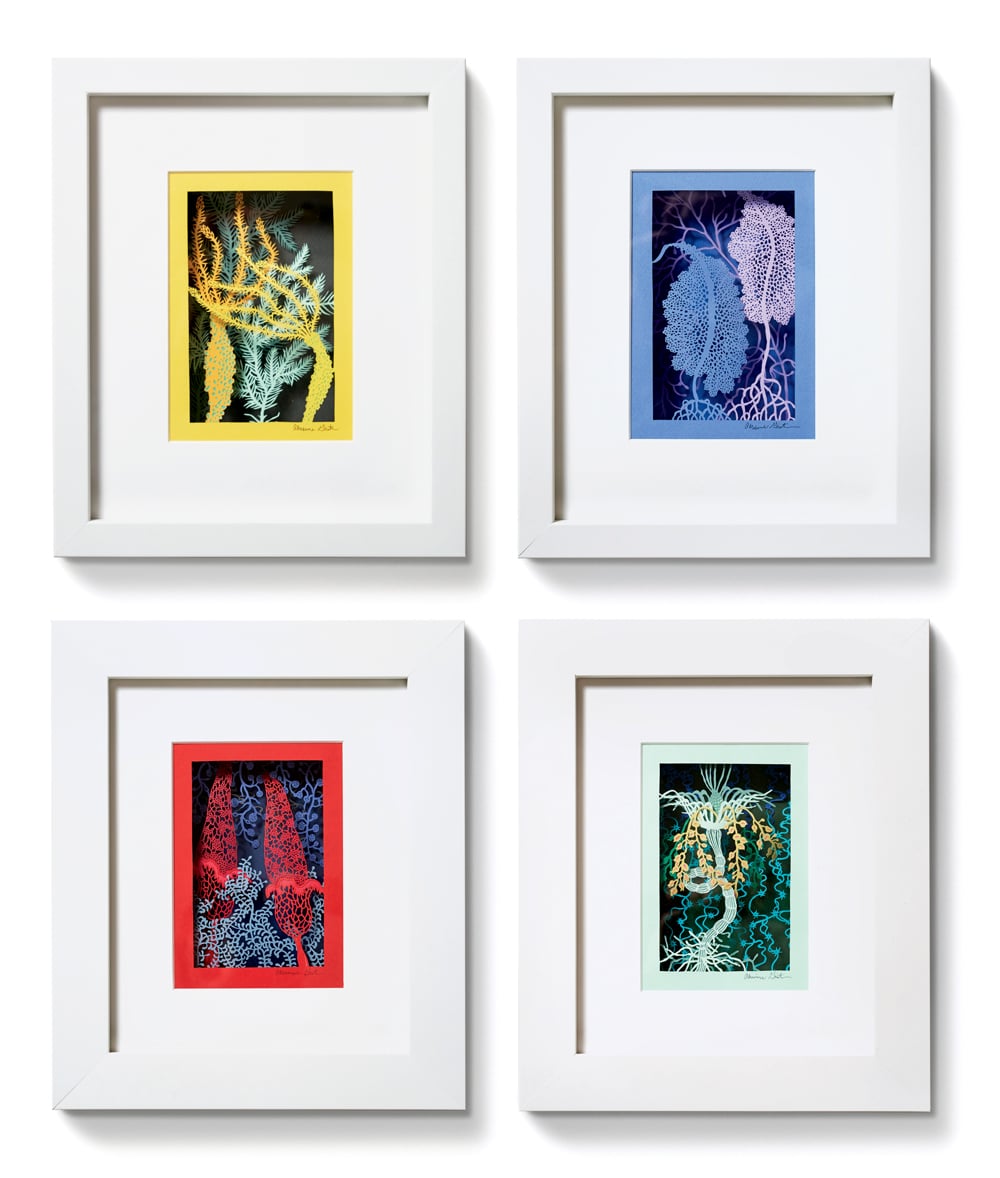
Adrienne Ginter, shown at far left amid scenes from her Brattleboro studio, says she taught herself how to work with paper in part by studying examples of Polish and Mexican paper cutting.
Photo Credit : Mark FlemingA couple of twists and turns from downtown Brattleboro—currently undergoing a Vermont-style Renaissance, with cafés and social activism sprouting in once-empty storefronts—the road winds down to a teal-blue mill building: the Whetstone Studio for the Arts, shouldering up against a nimble brook.Inside, the vast space is renovated to Brooklyn-loft standards: polished wood floors, high ceilings, thick beams, and stained glass windows that cast patches of deeply jeweled light. It is further sliced and diced into the kinds of studios that most artists dream of.

Photo Credit : Mark Fleming
Adrienne Ginter moves like a dancer through her second-story work space, an airy room that looks down on Whetstone Brook, but she’s up here in the crow’s nest, inhabiting a world of imagination. The walls are lined with landscapes, surreal in their colors and often fantastical, executed with a degree of detail and precision that seems beyond human ability. This is cut paper? Seriously? I’m catching a glimpse of what’s possible when ordinary tools land in extraordinary hands.
More precisely (and precision, in this case, is everything), we’re talking about someone fluent in the art of paper cutting, capable of wielding a swivel craft knife whose blade is not much wider than a thick eyelash. Edward Scissorhands with an X-Acto.
Ginter’s hand-cut visions are lacy, mystical, more fragile and elaborate than a paper doily, with multiple receding layers that create 3-D effects. Minuscule cuts pare away slivers of paper—behold, a stream of birds emerges. A tangle of Queen Anne’s lace lifts up in shades of sage and celery. Dark pointed firs hold on to their mystery against a twilit sky.
But then, as I look around, there are also tiny shadow boxes littering a desktop. Crazy little sculptures molded from tangled paper parings dominate a cube in the center of the room. Lacy bits of works in progress dangle from the walls—all insight into the multitude, beauty, and whimsy of the projects that Ginter’s got going.
“I’m ADD,” she confesses. “I get bored easily, so I’m always working on several things at once.” One of these is a collage for her daughter, who’s about to have her first birthday. The gift is a bold layering of white rabbits, fuzzy pale-peach flowers, and fuchsia snakes. As for the small paper sculptures, she shrugs. “I don’t know what to do with these yet!”
The Gilford, New Hampshire, native moved here from Boston four years ago with her husband, who also works with motion graphics and 3-D animation, and rented this studio in her first week. Her route to Brattleboro passed through the University of New Hampshire (BFA in painting) and Boston University (MFA in painting), with liberal doses of awards and gallery shows, plus a stint as a Realtor (she loved it). She began cutting paper 10 years ago, almost accidentally, while working on a mostly green oil painting called Jungle. It wasn’t flowing, and so “I went to Blick art supplies and bought every piece of green paper they had and started cutting.”
Right away, she liked the meditative quality of this new direction. A single layer of detailed cutwork can take up to 60 hours; one of her large pieces has 10 layers. “I work on five to 10 pieces at a time,” she says, “but if I worked on the same one, I would guess it takes two to three months.” Some have taken years. “Even then, I’m not sure when they’re finished,” she says ruefully. And while Ginter’s oil paintings are also intricately detailed, “there’s more control with paper, and I like the graphic quality.”

Photo Credit : Mark Fleming
There are also built-in restrictions. The Canson Mi-Tientes art paper she uses is ideal for cutting but has a limited palette: 40 colors. On the liberating side, “the nice thing about paper is that you can do it on a kitchen table. With oils, you need space.”
And yet Ginter is quick to add she doesn’t define herself as a paper artist. “I’m always experimenting, always doing something new and teaching myself.” Equal parts artist and extrovert, she ticks off antidotes to the stir-crazy solitude that might otherwise plague an outgoing creative type. She served on the board of the Arts Council of Windham County, teaches art, and does craft shows. For good measure, she co-owns Hazel, a lively self-described “pizza joint with a BBQ bend” on Elliot Street, a perfect exemplar of Brattleboro’s upbeat revival.
“I’m really social,” she says with a grin. “That’s a real perk when you’re an artist.”
Cards sell for $5; a 6-by-8-inch shadow box is $700; and 8-by-10-inch pieces sell for $900. For more information, email adrienne.ginter@gmail.com or go to adrienneginter.com.
Annie Graves
A New Hampshire native, Annie has been a writer and editor for over 25 years, while also composing music and writing young adult novels.
More by Annie Graves

